BUACC5931, Semester 1: Job Insecurity and Employee Well-being Report
VerifiedAdded on 2022/10/04
|9
|2295
|18
Report
AI Summary
This report analyzes a study by De Witte et al. (2010) investigating the associations between quantitative and qualitative job insecurity and employee well-being in the Belgian banking sector. The research involved a sample of 15,000 employees, approximately 21% of the population, selected through random sampling to ensure unbiased results. The study employed various measures of variables, including quantitative and qualitative job insecurity, job satisfaction, and psychological stress, using rating scales to gauge employee perceptions. The report details the advantages and disadvantages of random sampling, the measures of variables, data collection methods, and the use of control variables such as age, gender, and education. It also discusses the qualitative research design used, highlighting its strengths, such as the ability to clarify responses, and weaknesses, such as its dependence on researcher expertise and potential for inaccurate results. The report concludes by referencing key literature and providing a comprehensive overview of the study's methodology and findings.
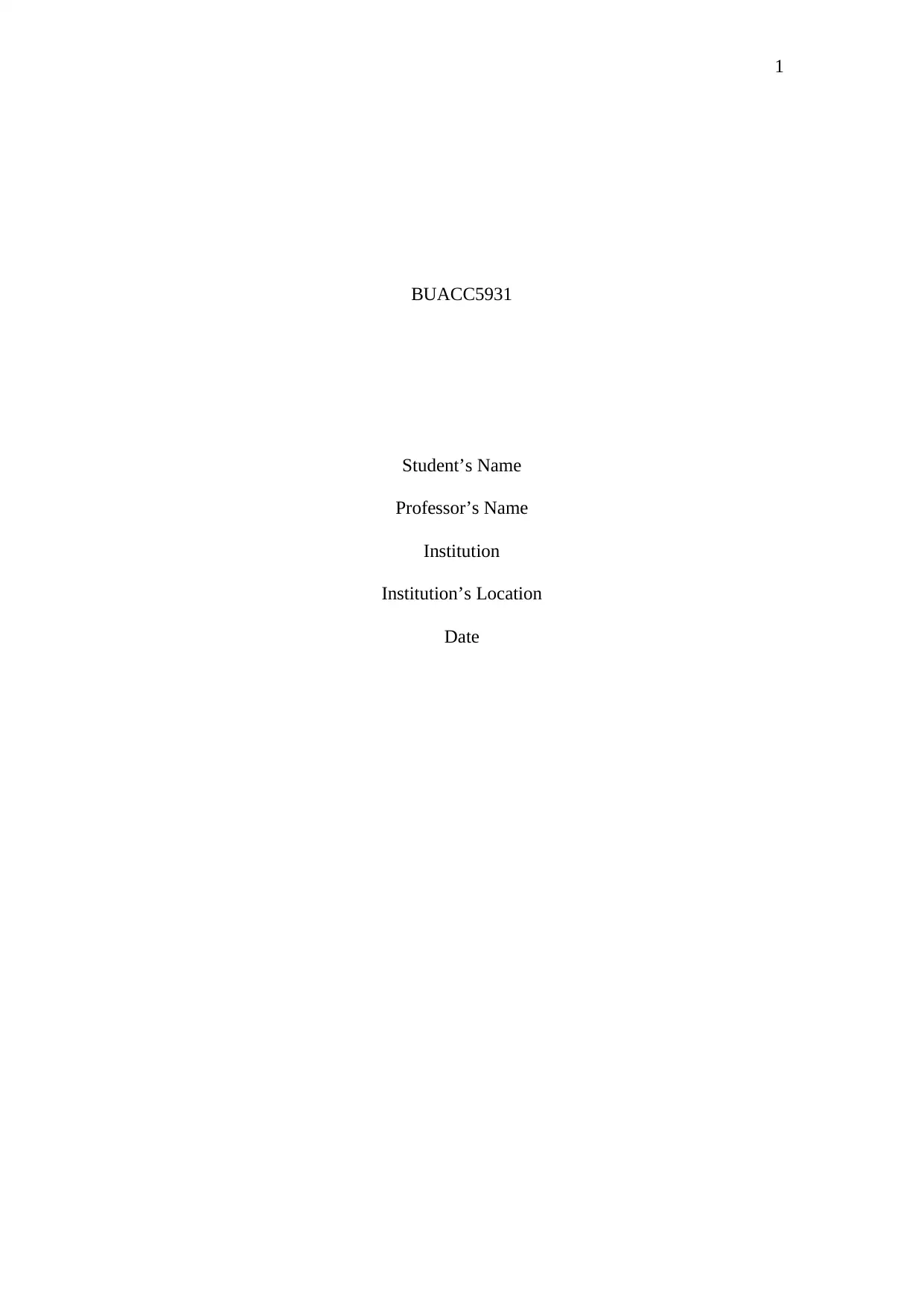
1
BUACC5931
Student’s Name
Professor’s Name
Institution
Institution’s Location
Date
BUACC5931
Student’s Name
Professor’s Name
Institution
Institution’s Location
Date
Paraphrase This Document
Need a fresh take? Get an instant paraphrase of this document with our AI Paraphraser
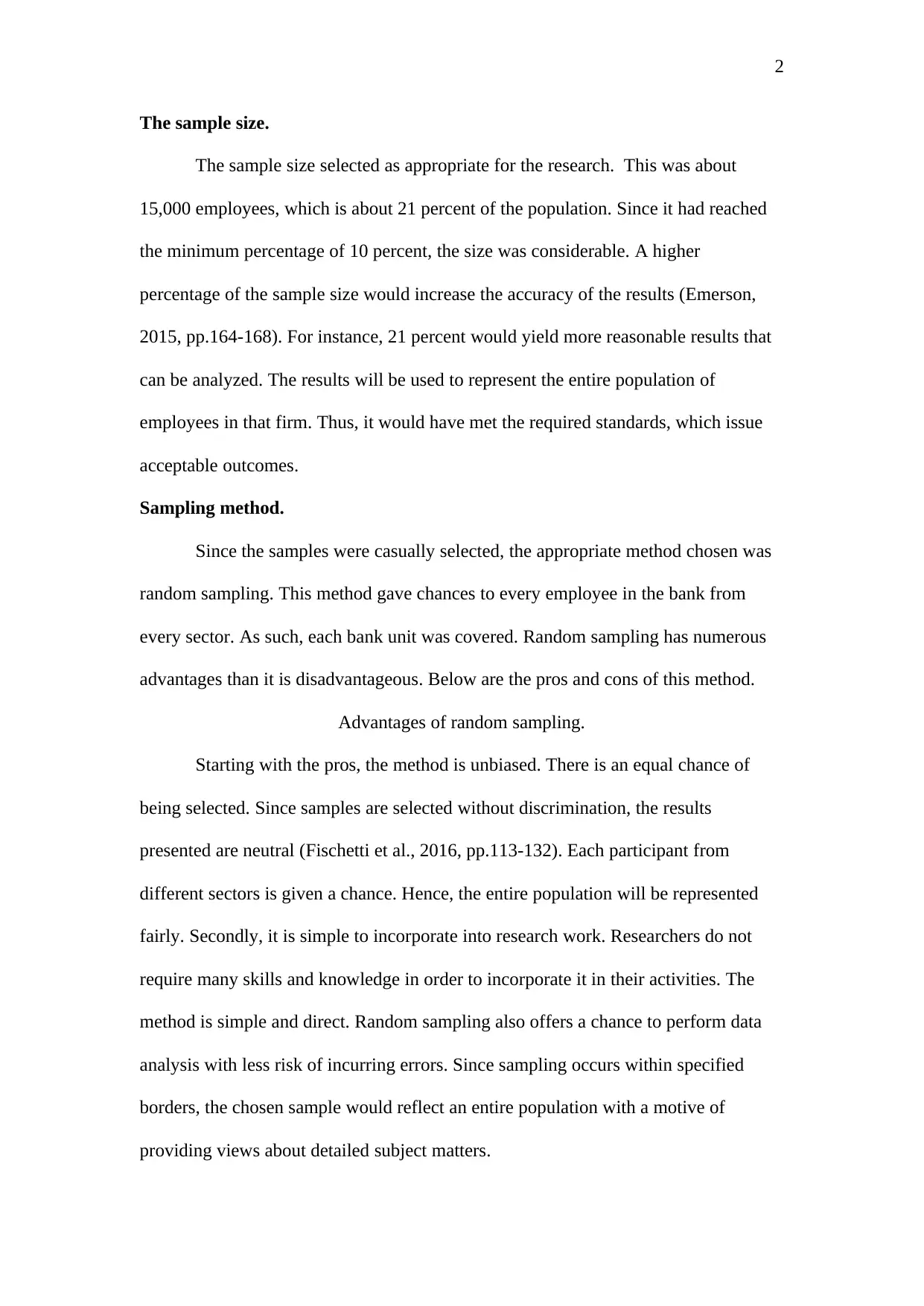
2
The sample size.
The sample size selected as appropriate for the research. This was about
15,000 employees, which is about 21 percent of the population. Since it had reached
the minimum percentage of 10 percent, the size was considerable. A higher
percentage of the sample size would increase the accuracy of the results (Emerson,
2015, pp.164-168). For instance, 21 percent would yield more reasonable results that
can be analyzed. The results will be used to represent the entire population of
employees in that firm. Thus, it would have met the required standards, which issue
acceptable outcomes.
Sampling method.
Since the samples were casually selected, the appropriate method chosen was
random sampling. This method gave chances to every employee in the bank from
every sector. As such, each bank unit was covered. Random sampling has numerous
advantages than it is disadvantageous. Below are the pros and cons of this method.
Advantages of random sampling.
Starting with the pros, the method is unbiased. There is an equal chance of
being selected. Since samples are selected without discrimination, the results
presented are neutral (Fischetti et al., 2016, pp.113-132). Each participant from
different sectors is given a chance. Hence, the entire population will be represented
fairly. Secondly, it is simple to incorporate into research work. Researchers do not
require many skills and knowledge in order to incorporate it in their activities. The
method is simple and direct. Random sampling also offers a chance to perform data
analysis with less risk of incurring errors. Since sampling occurs within specified
borders, the chosen sample would reflect an entire population with a motive of
providing views about detailed subject matters.
The sample size.
The sample size selected as appropriate for the research. This was about
15,000 employees, which is about 21 percent of the population. Since it had reached
the minimum percentage of 10 percent, the size was considerable. A higher
percentage of the sample size would increase the accuracy of the results (Emerson,
2015, pp.164-168). For instance, 21 percent would yield more reasonable results that
can be analyzed. The results will be used to represent the entire population of
employees in that firm. Thus, it would have met the required standards, which issue
acceptable outcomes.
Sampling method.
Since the samples were casually selected, the appropriate method chosen was
random sampling. This method gave chances to every employee in the bank from
every sector. As such, each bank unit was covered. Random sampling has numerous
advantages than it is disadvantageous. Below are the pros and cons of this method.
Advantages of random sampling.
Starting with the pros, the method is unbiased. There is an equal chance of
being selected. Since samples are selected without discrimination, the results
presented are neutral (Fischetti et al., 2016, pp.113-132). Each participant from
different sectors is given a chance. Hence, the entire population will be represented
fairly. Secondly, it is simple to incorporate into research work. Researchers do not
require many skills and knowledge in order to incorporate it in their activities. The
method is simple and direct. Random sampling also offers a chance to perform data
analysis with less risk of incurring errors. Since sampling occurs within specified
borders, the chosen sample would reflect an entire population with a motive of
providing views about detailed subject matters.
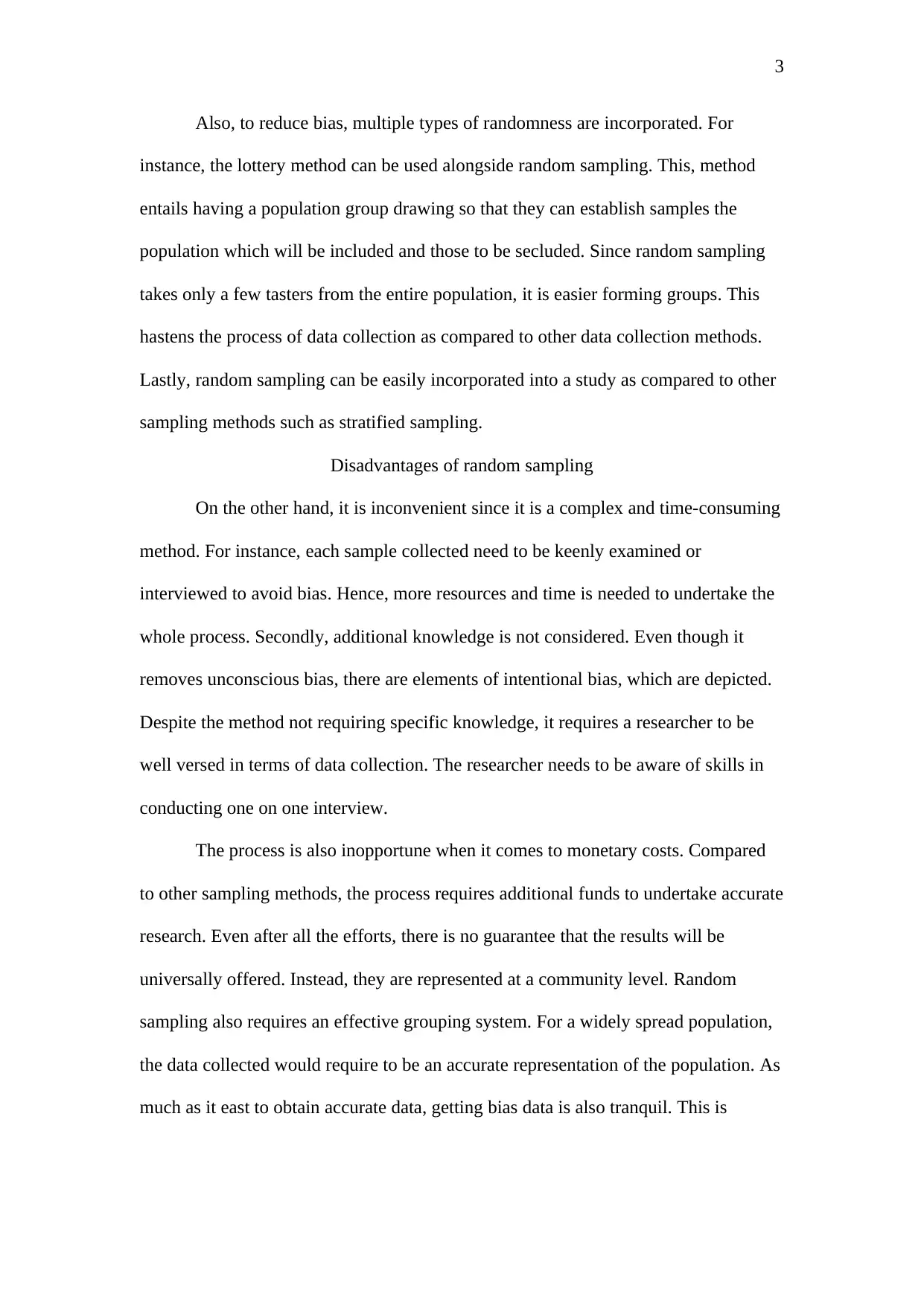
3
Also, to reduce bias, multiple types of randomness are incorporated. For
instance, the lottery method can be used alongside random sampling. This, method
entails having a population group drawing so that they can establish samples the
population which will be included and those to be secluded. Since random sampling
takes only a few tasters from the entire population, it is easier forming groups. This
hastens the process of data collection as compared to other data collection methods.
Lastly, random sampling can be easily incorporated into a study as compared to other
sampling methods such as stratified sampling.
Disadvantages of random sampling
On the other hand, it is inconvenient since it is a complex and time-consuming
method. For instance, each sample collected need to be keenly examined or
interviewed to avoid bias. Hence, more resources and time is needed to undertake the
whole process. Secondly, additional knowledge is not considered. Even though it
removes unconscious bias, there are elements of intentional bias, which are depicted.
Despite the method not requiring specific knowledge, it requires a researcher to be
well versed in terms of data collection. The researcher needs to be aware of skills in
conducting one on one interview.
The process is also inopportune when it comes to monetary costs. Compared
to other sampling methods, the process requires additional funds to undertake accurate
research. Even after all the efforts, there is no guarantee that the results will be
universally offered. Instead, they are represented at a community level. Random
sampling also requires an effective grouping system. For a widely spread population,
the data collected would require to be an accurate representation of the population. As
much as it east to obtain accurate data, getting bias data is also tranquil. This is
Also, to reduce bias, multiple types of randomness are incorporated. For
instance, the lottery method can be used alongside random sampling. This, method
entails having a population group drawing so that they can establish samples the
population which will be included and those to be secluded. Since random sampling
takes only a few tasters from the entire population, it is easier forming groups. This
hastens the process of data collection as compared to other data collection methods.
Lastly, random sampling can be easily incorporated into a study as compared to other
sampling methods such as stratified sampling.
Disadvantages of random sampling
On the other hand, it is inconvenient since it is a complex and time-consuming
method. For instance, each sample collected need to be keenly examined or
interviewed to avoid bias. Hence, more resources and time is needed to undertake the
whole process. Secondly, additional knowledge is not considered. Even though it
removes unconscious bias, there are elements of intentional bias, which are depicted.
Despite the method not requiring specific knowledge, it requires a researcher to be
well versed in terms of data collection. The researcher needs to be aware of skills in
conducting one on one interview.
The process is also inopportune when it comes to monetary costs. Compared
to other sampling methods, the process requires additional funds to undertake accurate
research. Even after all the efforts, there is no guarantee that the results will be
universally offered. Instead, they are represented at a community level. Random
sampling also requires an effective grouping system. For a widely spread population,
the data collected would require to be an accurate representation of the population. As
much as it east to obtain accurate data, getting bias data is also tranquil. This is
⊘ This is a preview!⊘
Do you want full access?
Subscribe today to unlock all pages.

Trusted by 1+ million students worldwide
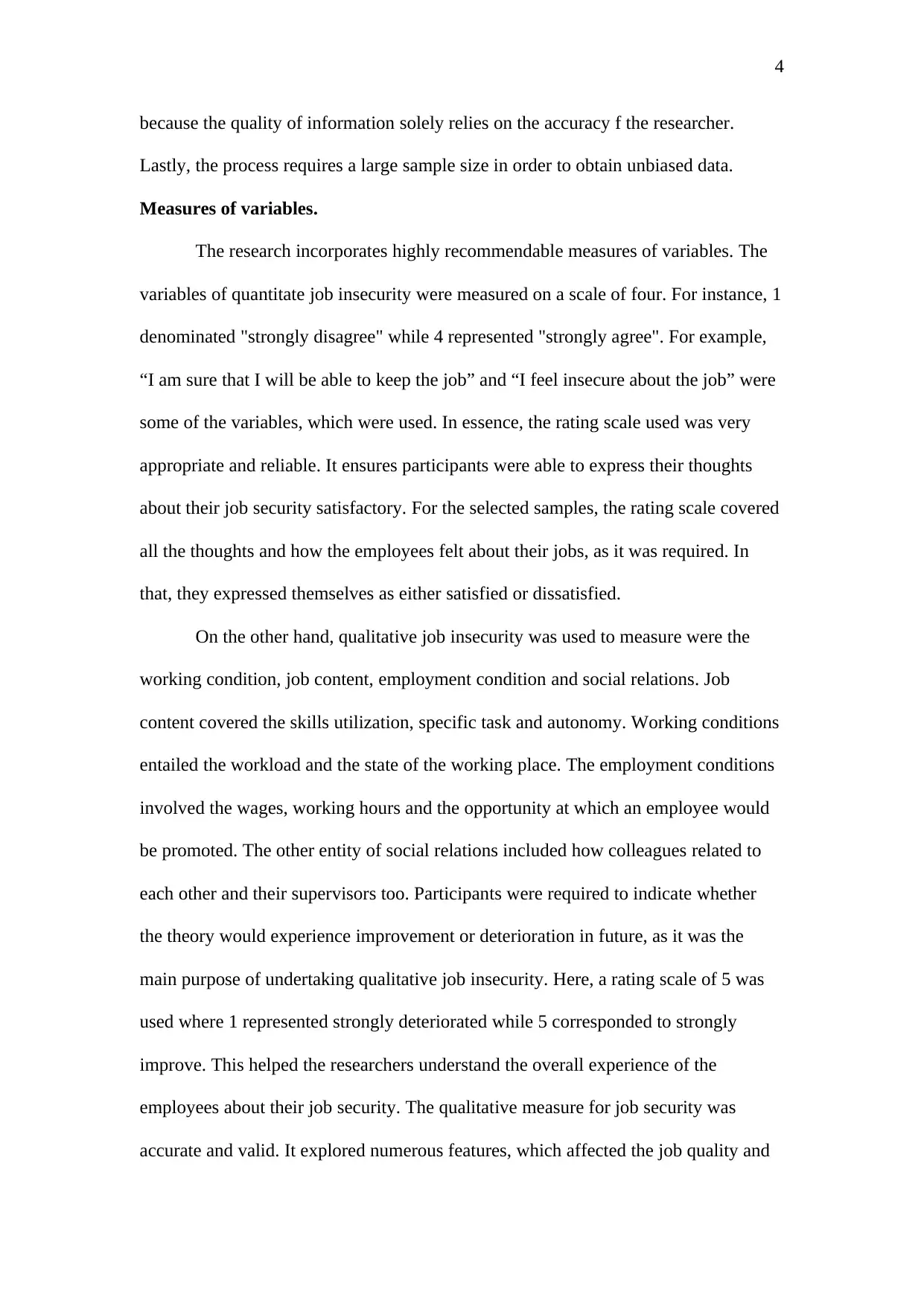
4
because the quality of information solely relies on the accuracy f the researcher.
Lastly, the process requires a large sample size in order to obtain unbiased data.
Measures of variables.
The research incorporates highly recommendable measures of variables. The
variables of quantitate job insecurity were measured on a scale of four. For instance, 1
denominated "strongly disagree" while 4 represented "strongly agree". For example,
“I am sure that I will be able to keep the job” and “I feel insecure about the job” were
some of the variables, which were used. In essence, the rating scale used was very
appropriate and reliable. It ensures participants were able to express their thoughts
about their job security satisfactory. For the selected samples, the rating scale covered
all the thoughts and how the employees felt about their jobs, as it was required. In
that, they expressed themselves as either satisfied or dissatisfied.
On the other hand, qualitative job insecurity was used to measure were the
working condition, job content, employment condition and social relations. Job
content covered the skills utilization, specific task and autonomy. Working conditions
entailed the workload and the state of the working place. The employment conditions
involved the wages, working hours and the opportunity at which an employee would
be promoted. The other entity of social relations included how colleagues related to
each other and their supervisors too. Participants were required to indicate whether
the theory would experience improvement or deterioration in future, as it was the
main purpose of undertaking qualitative job insecurity. Here, a rating scale of 5 was
used where 1 represented strongly deteriorated while 5 corresponded to strongly
improve. This helped the researchers understand the overall experience of the
employees about their job security. The qualitative measure for job security was
accurate and valid. It explored numerous features, which affected the job quality and
because the quality of information solely relies on the accuracy f the researcher.
Lastly, the process requires a large sample size in order to obtain unbiased data.
Measures of variables.
The research incorporates highly recommendable measures of variables. The
variables of quantitate job insecurity were measured on a scale of four. For instance, 1
denominated "strongly disagree" while 4 represented "strongly agree". For example,
“I am sure that I will be able to keep the job” and “I feel insecure about the job” were
some of the variables, which were used. In essence, the rating scale used was very
appropriate and reliable. It ensures participants were able to express their thoughts
about their job security satisfactory. For the selected samples, the rating scale covered
all the thoughts and how the employees felt about their jobs, as it was required. In
that, they expressed themselves as either satisfied or dissatisfied.
On the other hand, qualitative job insecurity was used to measure were the
working condition, job content, employment condition and social relations. Job
content covered the skills utilization, specific task and autonomy. Working conditions
entailed the workload and the state of the working place. The employment conditions
involved the wages, working hours and the opportunity at which an employee would
be promoted. The other entity of social relations included how colleagues related to
each other and their supervisors too. Participants were required to indicate whether
the theory would experience improvement or deterioration in future, as it was the
main purpose of undertaking qualitative job insecurity. Here, a rating scale of 5 was
used where 1 represented strongly deteriorated while 5 corresponded to strongly
improve. This helped the researchers understand the overall experience of the
employees about their job security. The qualitative measure for job security was
accurate and valid. It explored numerous features, which affected the job quality and
Paraphrase This Document
Need a fresh take? Get an instant paraphrase of this document with our AI Paraphraser
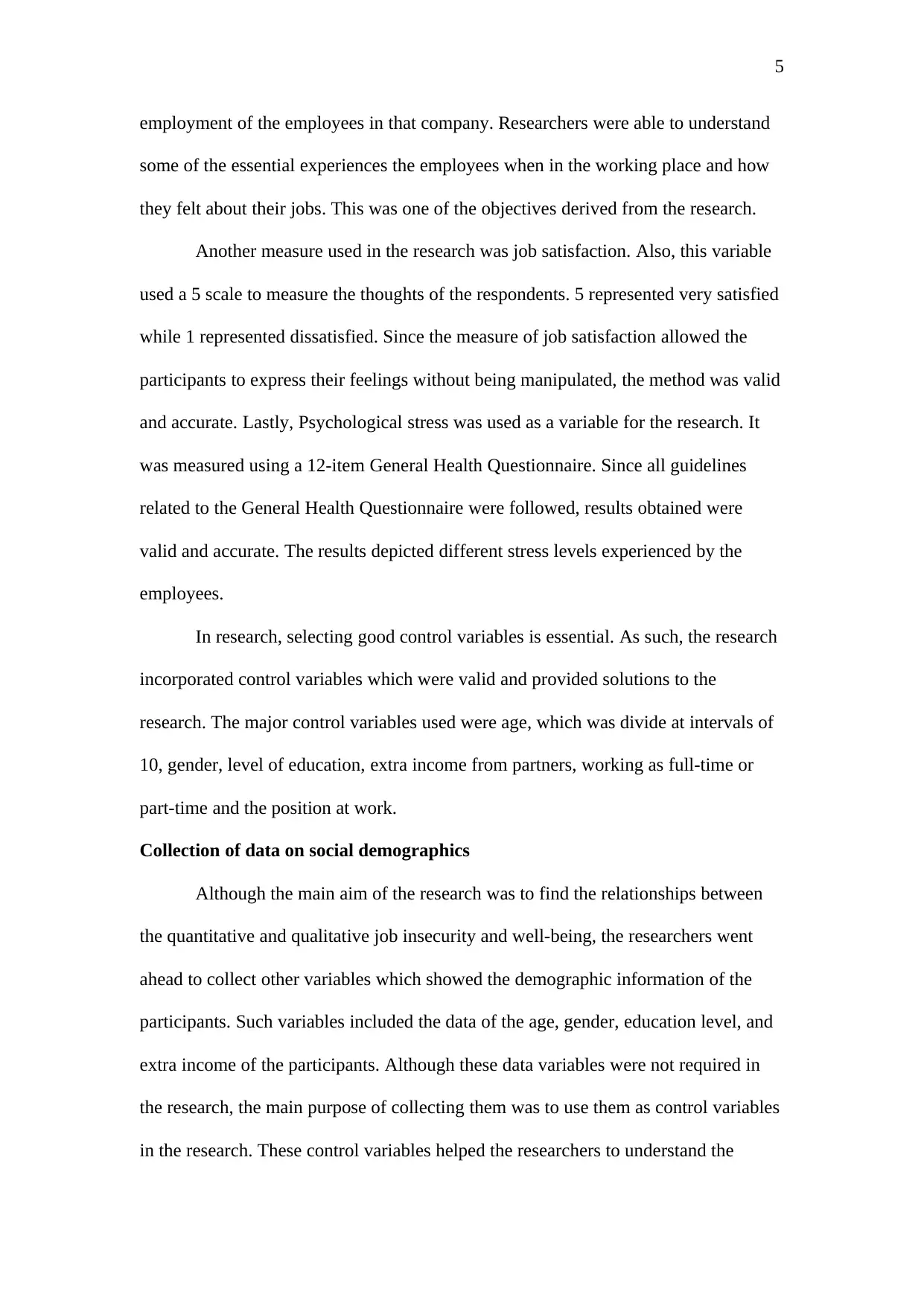
5
employment of the employees in that company. Researchers were able to understand
some of the essential experiences the employees when in the working place and how
they felt about their jobs. This was one of the objectives derived from the research.
Another measure used in the research was job satisfaction. Also, this variable
used a 5 scale to measure the thoughts of the respondents. 5 represented very satisfied
while 1 represented dissatisfied. Since the measure of job satisfaction allowed the
participants to express their feelings without being manipulated, the method was valid
and accurate. Lastly, Psychological stress was used as a variable for the research. It
was measured using a 12-item General Health Questionnaire. Since all guidelines
related to the General Health Questionnaire were followed, results obtained were
valid and accurate. The results depicted different stress levels experienced by the
employees.
In research, selecting good control variables is essential. As such, the research
incorporated control variables which were valid and provided solutions to the
research. The major control variables used were age, which was divide at intervals of
10, gender, level of education, extra income from partners, working as full-time or
part-time and the position at work.
Collection of data on social demographics
Although the main aim of the research was to find the relationships between
the quantitative and qualitative job insecurity and well-being, the researchers went
ahead to collect other variables which showed the demographic information of the
participants. Such variables included the data of the age, gender, education level, and
extra income of the participants. Although these data variables were not required in
the research, the main purpose of collecting them was to use them as control variables
in the research. These control variables helped the researchers to understand the
employment of the employees in that company. Researchers were able to understand
some of the essential experiences the employees when in the working place and how
they felt about their jobs. This was one of the objectives derived from the research.
Another measure used in the research was job satisfaction. Also, this variable
used a 5 scale to measure the thoughts of the respondents. 5 represented very satisfied
while 1 represented dissatisfied. Since the measure of job satisfaction allowed the
participants to express their feelings without being manipulated, the method was valid
and accurate. Lastly, Psychological stress was used as a variable for the research. It
was measured using a 12-item General Health Questionnaire. Since all guidelines
related to the General Health Questionnaire were followed, results obtained were
valid and accurate. The results depicted different stress levels experienced by the
employees.
In research, selecting good control variables is essential. As such, the research
incorporated control variables which were valid and provided solutions to the
research. The major control variables used were age, which was divide at intervals of
10, gender, level of education, extra income from partners, working as full-time or
part-time and the position at work.
Collection of data on social demographics
Although the main aim of the research was to find the relationships between
the quantitative and qualitative job insecurity and well-being, the researchers went
ahead to collect other variables which showed the demographic information of the
participants. Such variables included the data of the age, gender, education level, and
extra income of the participants. Although these data variables were not required in
the research, the main purpose of collecting them was to use them as control variables
in the research. These control variables helped the researchers to understand the
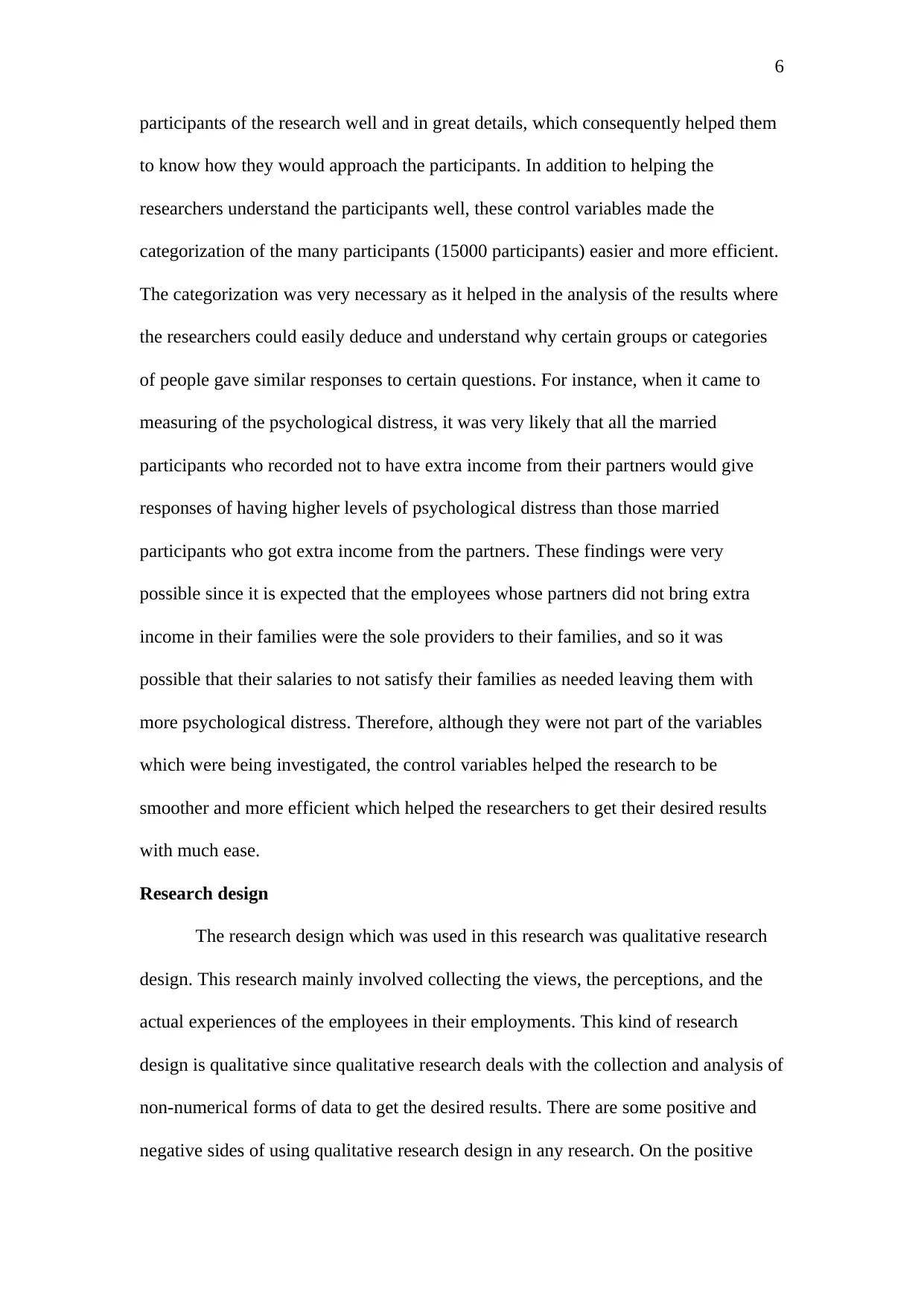
6
participants of the research well and in great details, which consequently helped them
to know how they would approach the participants. In addition to helping the
researchers understand the participants well, these control variables made the
categorization of the many participants (15000 participants) easier and more efficient.
The categorization was very necessary as it helped in the analysis of the results where
the researchers could easily deduce and understand why certain groups or categories
of people gave similar responses to certain questions. For instance, when it came to
measuring of the psychological distress, it was very likely that all the married
participants who recorded not to have extra income from their partners would give
responses of having higher levels of psychological distress than those married
participants who got extra income from the partners. These findings were very
possible since it is expected that the employees whose partners did not bring extra
income in their families were the sole providers to their families, and so it was
possible that their salaries to not satisfy their families as needed leaving them with
more psychological distress. Therefore, although they were not part of the variables
which were being investigated, the control variables helped the research to be
smoother and more efficient which helped the researchers to get their desired results
with much ease.
Research design
The research design which was used in this research was qualitative research
design. This research mainly involved collecting the views, the perceptions, and the
actual experiences of the employees in their employments. This kind of research
design is qualitative since qualitative research deals with the collection and analysis of
non-numerical forms of data to get the desired results. There are some positive and
negative sides of using qualitative research design in any research. On the positive
participants of the research well and in great details, which consequently helped them
to know how they would approach the participants. In addition to helping the
researchers understand the participants well, these control variables made the
categorization of the many participants (15000 participants) easier and more efficient.
The categorization was very necessary as it helped in the analysis of the results where
the researchers could easily deduce and understand why certain groups or categories
of people gave similar responses to certain questions. For instance, when it came to
measuring of the psychological distress, it was very likely that all the married
participants who recorded not to have extra income from their partners would give
responses of having higher levels of psychological distress than those married
participants who got extra income from the partners. These findings were very
possible since it is expected that the employees whose partners did not bring extra
income in their families were the sole providers to their families, and so it was
possible that their salaries to not satisfy their families as needed leaving them with
more psychological distress. Therefore, although they were not part of the variables
which were being investigated, the control variables helped the research to be
smoother and more efficient which helped the researchers to get their desired results
with much ease.
Research design
The research design which was used in this research was qualitative research
design. This research mainly involved collecting the views, the perceptions, and the
actual experiences of the employees in their employments. This kind of research
design is qualitative since qualitative research deals with the collection and analysis of
non-numerical forms of data to get the desired results. There are some positive and
negative sides of using qualitative research design in any research. On the positive
⊘ This is a preview!⊘
Do you want full access?
Subscribe today to unlock all pages.

Trusted by 1+ million students worldwide
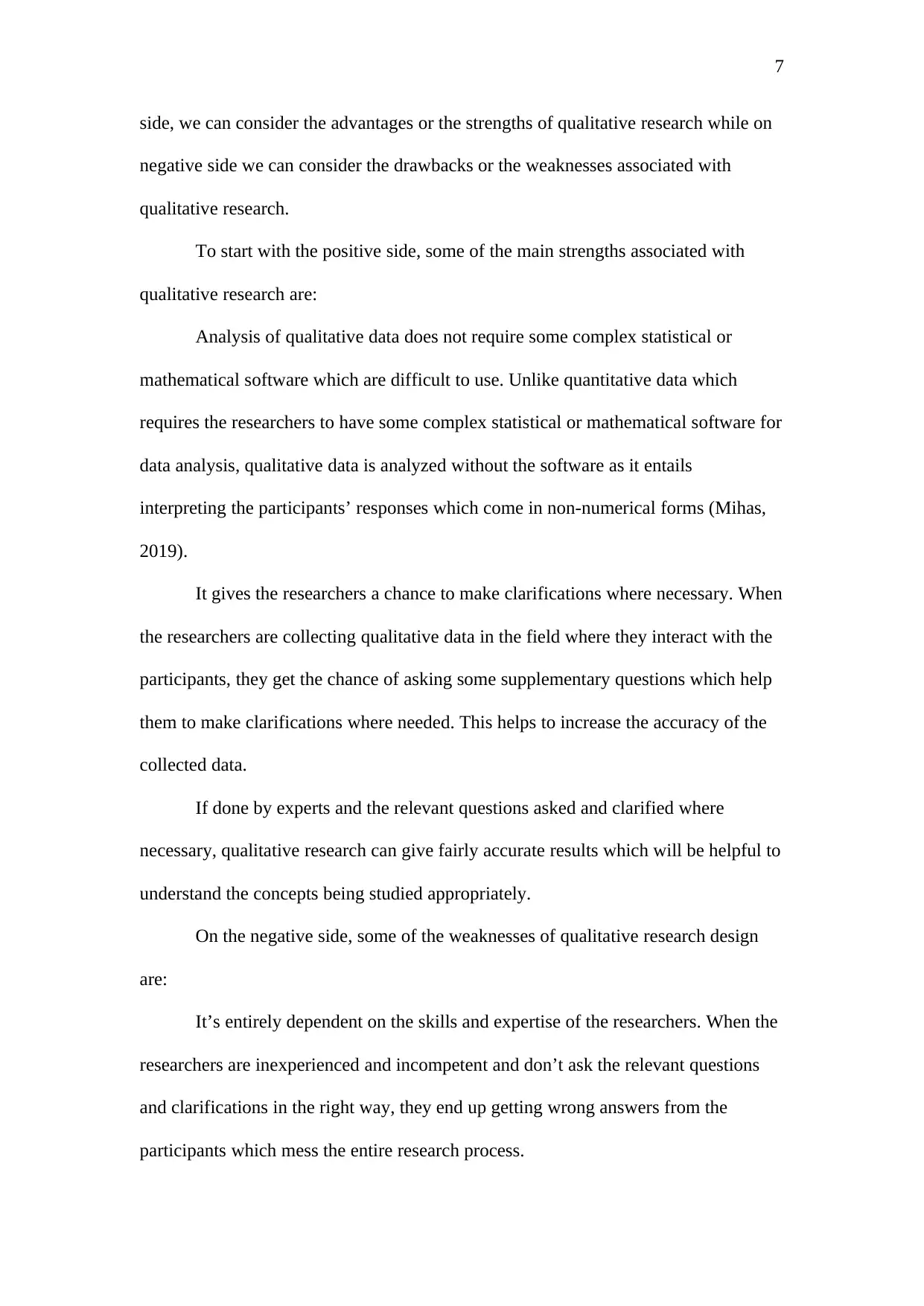
7
side, we can consider the advantages or the strengths of qualitative research while on
negative side we can consider the drawbacks or the weaknesses associated with
qualitative research.
To start with the positive side, some of the main strengths associated with
qualitative research are:
Analysis of qualitative data does not require some complex statistical or
mathematical software which are difficult to use. Unlike quantitative data which
requires the researchers to have some complex statistical or mathematical software for
data analysis, qualitative data is analyzed without the software as it entails
interpreting the participants’ responses which come in non-numerical forms (Mihas,
2019).
It gives the researchers a chance to make clarifications where necessary. When
the researchers are collecting qualitative data in the field where they interact with the
participants, they get the chance of asking some supplementary questions which help
them to make clarifications where needed. This helps to increase the accuracy of the
collected data.
If done by experts and the relevant questions asked and clarified where
necessary, qualitative research can give fairly accurate results which will be helpful to
understand the concepts being studied appropriately.
On the negative side, some of the weaknesses of qualitative research design
are:
It’s entirely dependent on the skills and expertise of the researchers. When the
researchers are inexperienced and incompetent and don’t ask the relevant questions
and clarifications in the right way, they end up getting wrong answers from the
participants which mess the entire research process.
side, we can consider the advantages or the strengths of qualitative research while on
negative side we can consider the drawbacks or the weaknesses associated with
qualitative research.
To start with the positive side, some of the main strengths associated with
qualitative research are:
Analysis of qualitative data does not require some complex statistical or
mathematical software which are difficult to use. Unlike quantitative data which
requires the researchers to have some complex statistical or mathematical software for
data analysis, qualitative data is analyzed without the software as it entails
interpreting the participants’ responses which come in non-numerical forms (Mihas,
2019).
It gives the researchers a chance to make clarifications where necessary. When
the researchers are collecting qualitative data in the field where they interact with the
participants, they get the chance of asking some supplementary questions which help
them to make clarifications where needed. This helps to increase the accuracy of the
collected data.
If done by experts and the relevant questions asked and clarified where
necessary, qualitative research can give fairly accurate results which will be helpful to
understand the concepts being studied appropriately.
On the negative side, some of the weaknesses of qualitative research design
are:
It’s entirely dependent on the skills and expertise of the researchers. When the
researchers are inexperienced and incompetent and don’t ask the relevant questions
and clarifications in the right way, they end up getting wrong answers from the
participants which mess the entire research process.
Paraphrase This Document
Need a fresh take? Get an instant paraphrase of this document with our AI Paraphraser
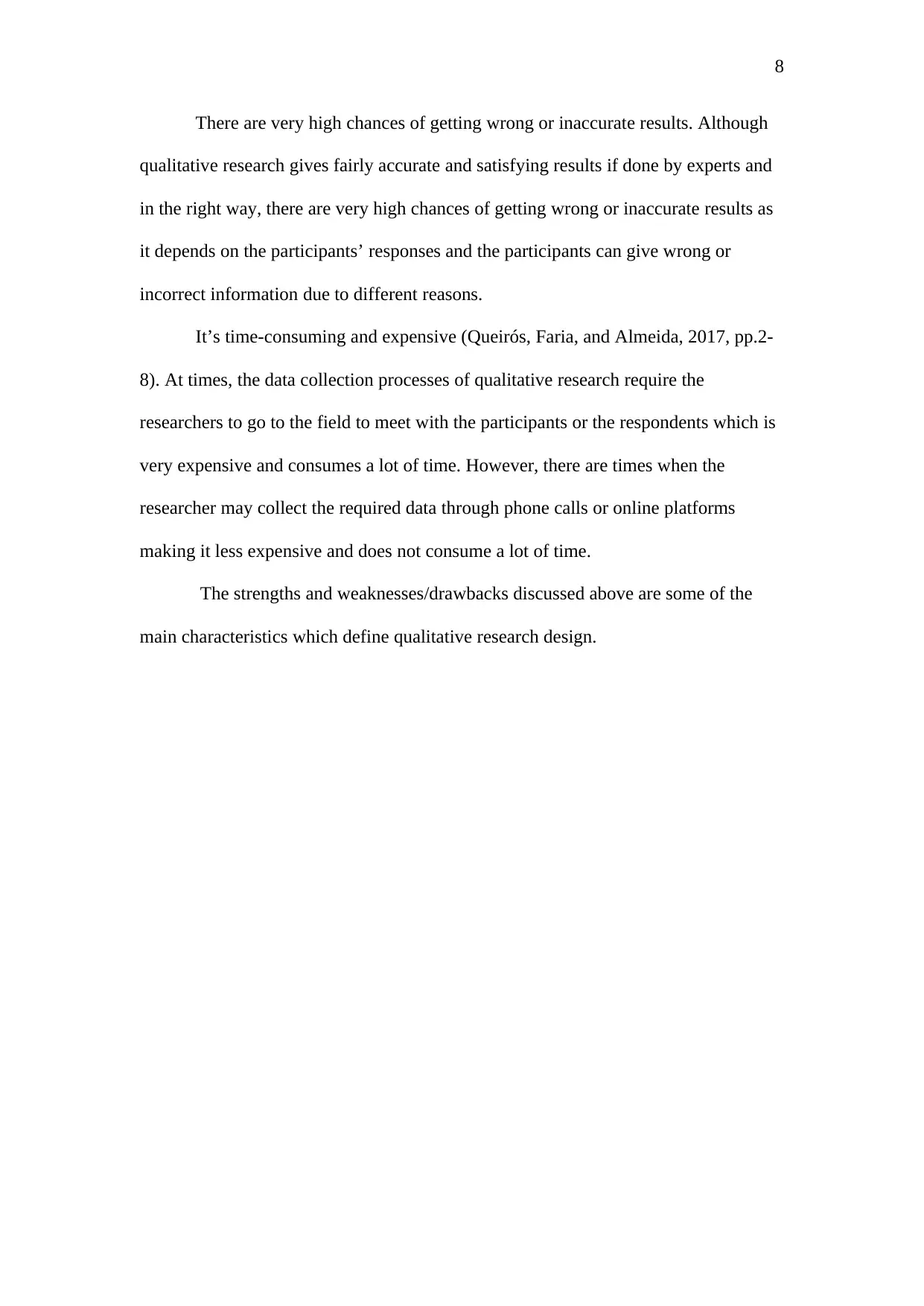
8
There are very high chances of getting wrong or inaccurate results. Although
qualitative research gives fairly accurate and satisfying results if done by experts and
in the right way, there are very high chances of getting wrong or inaccurate results as
it depends on the participants’ responses and the participants can give wrong or
incorrect information due to different reasons.
It’s time-consuming and expensive (Queirós, Faria, and Almeida, 2017, pp.2-
8). At times, the data collection processes of qualitative research require the
researchers to go to the field to meet with the participants or the respondents which is
very expensive and consumes a lot of time. However, there are times when the
researcher may collect the required data through phone calls or online platforms
making it less expensive and does not consume a lot of time.
The strengths and weaknesses/drawbacks discussed above are some of the
main characteristics which define qualitative research design.
There are very high chances of getting wrong or inaccurate results. Although
qualitative research gives fairly accurate and satisfying results if done by experts and
in the right way, there are very high chances of getting wrong or inaccurate results as
it depends on the participants’ responses and the participants can give wrong or
incorrect information due to different reasons.
It’s time-consuming and expensive (Queirós, Faria, and Almeida, 2017, pp.2-
8). At times, the data collection processes of qualitative research require the
researchers to go to the field to meet with the participants or the respondents which is
very expensive and consumes a lot of time. However, there are times when the
researcher may collect the required data through phone calls or online platforms
making it less expensive and does not consume a lot of time.
The strengths and weaknesses/drawbacks discussed above are some of the
main characteristics which define qualitative research design.
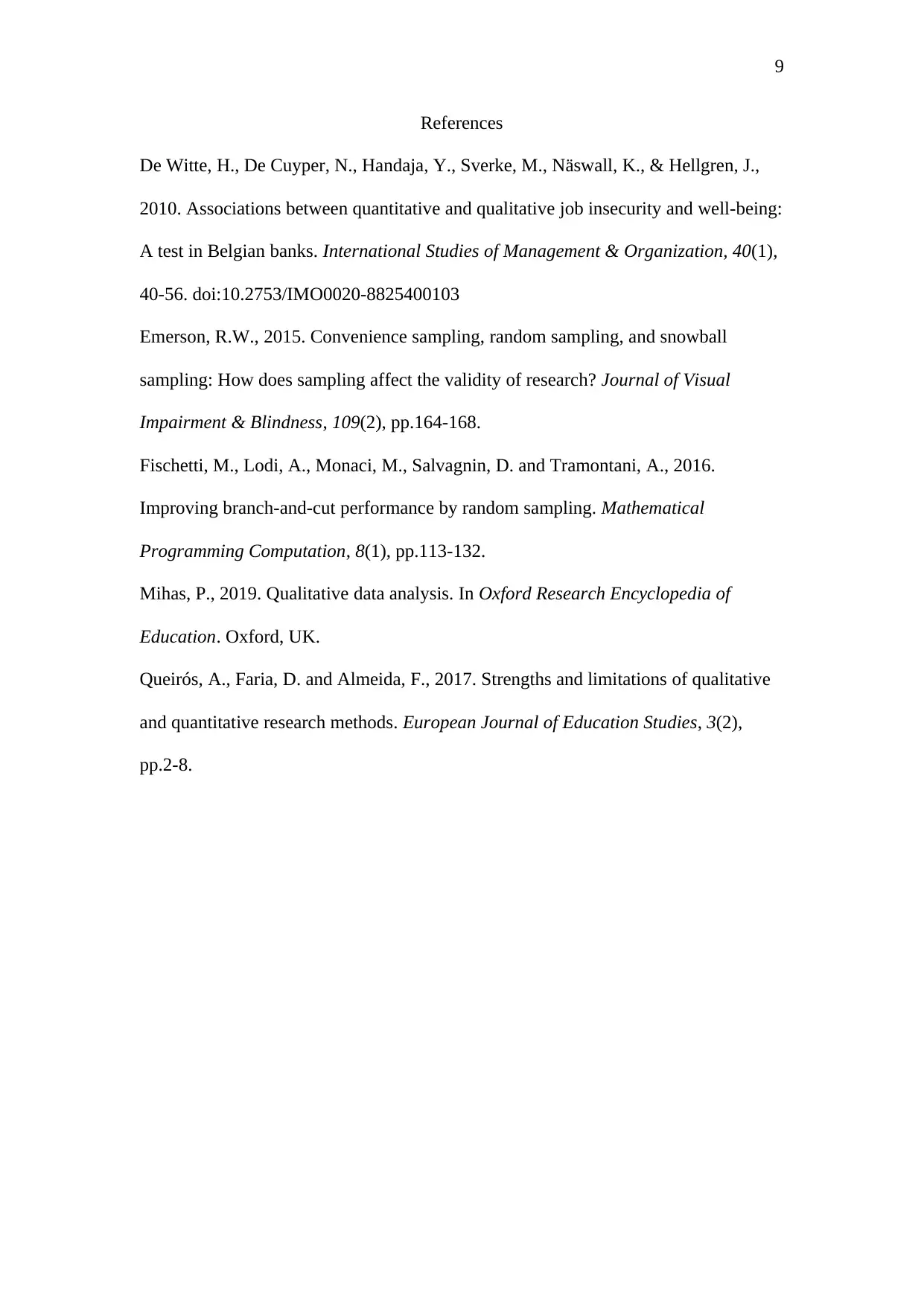
9
References
De Witte, H., De Cuyper, N., Handaja, Y., Sverke, M., Näswall, K., & Hellgren, J.,
2010. Associations between quantitative and qualitative job insecurity and well-being:
A test in Belgian banks. International Studies of Management & Organization, 40(1),
40-56. doi:10.2753/IMO0020-8825400103
Emerson, R.W., 2015. Convenience sampling, random sampling, and snowball
sampling: How does sampling affect the validity of research? Journal of Visual
Impairment & Blindness, 109(2), pp.164-168.
Fischetti, M., Lodi, A., Monaci, M., Salvagnin, D. and Tramontani, A., 2016.
Improving branch-and-cut performance by random sampling. Mathematical
Programming Computation, 8(1), pp.113-132.
Mihas, P., 2019. Qualitative data analysis. In Oxford Research Encyclopedia of
Education. Oxford, UK.
Queirós, A., Faria, D. and Almeida, F., 2017. Strengths and limitations of qualitative
and quantitative research methods. European Journal of Education Studies, 3(2),
pp.2-8.
References
De Witte, H., De Cuyper, N., Handaja, Y., Sverke, M., Näswall, K., & Hellgren, J.,
2010. Associations between quantitative and qualitative job insecurity and well-being:
A test in Belgian banks. International Studies of Management & Organization, 40(1),
40-56. doi:10.2753/IMO0020-8825400103
Emerson, R.W., 2015. Convenience sampling, random sampling, and snowball
sampling: How does sampling affect the validity of research? Journal of Visual
Impairment & Blindness, 109(2), pp.164-168.
Fischetti, M., Lodi, A., Monaci, M., Salvagnin, D. and Tramontani, A., 2016.
Improving branch-and-cut performance by random sampling. Mathematical
Programming Computation, 8(1), pp.113-132.
Mihas, P., 2019. Qualitative data analysis. In Oxford Research Encyclopedia of
Education. Oxford, UK.
Queirós, A., Faria, D. and Almeida, F., 2017. Strengths and limitations of qualitative
and quantitative research methods. European Journal of Education Studies, 3(2),
pp.2-8.
⊘ This is a preview!⊘
Do you want full access?
Subscribe today to unlock all pages.

Trusted by 1+ million students worldwide
1 out of 9
Related Documents
Your All-in-One AI-Powered Toolkit for Academic Success.
+13062052269
info@desklib.com
Available 24*7 on WhatsApp / Email
![[object Object]](/_next/static/media/star-bottom.7253800d.svg)
Unlock your academic potential
Copyright © 2020–2025 A2Z Services. All Rights Reserved. Developed and managed by ZUCOL.





